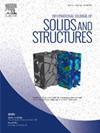超弹性镍钛形状记忆合金拉伸-压缩不对称功能疲劳的构造建模
IF 3.4
3区 工程技术
Q1 MECHANICS
International Journal of Solids and Structures
Pub Date : 2024-10-05
DOI:10.1016/j.ijsolstr.2024.113099
引用次数: 0
摘要
在循环载荷作用下,超弹性形状记忆合金(SMA)表现出以功能疲劳为特征的应力-应变响应,即随着循环次数的增加,超弹性下降,不可恢复的变形累积,以及拉伸和压缩响应之间的不对称。对这些材料复杂性的全面理解和建模对于设计和分析实际应用中的各种超弹性 SMA 结构至关重要。这项研究基于不可逆热力学开发了一种新的构成模型,用于解释具有拉伸-压缩不对称的功能疲劳。该模型采用了一个电位函数(定义为两个电位的加权和,分别针对拉伸和压缩响应进行校准)来生成非对称响应,并通过超弹性性能的退化和马氏体转变累积时塑性应变的增长来表示功能疲劳。该模型用于循环横向压缩条件下超弹性 SMA 管的数值模拟,并作为模型问题进行了实验研究。模拟与实验之间的一致性表明了该构成模型的有效性。通过结合该模型的额外有限元模拟,还揭示了循环下拉伸-压缩不对称以及管材几何形状的直径-厚度比对横向压缩 SMA 管机械响应的影响。本文章由计算机程序翻译,如有差异,请以英文原文为准。
Constitutive modeling of functional fatigue with tension–compression asymmetry for superelastic NiTi shape memory alloy
Under cyclic loads, superelastic shape memory alloys (SMAs) exhibit stress–strain responses featured by functional fatigue, i.e., degradation of superelasticity and accumulation of irrecoverable deformation as cycling number increases, together with an asymmetry between tensile and compressive responses. Comprehensive understanding and modeling of these material complexities are crucial for the design and analysis of various superelastic SMA structures in practical applications. This work has developed a novel constitutive model based on irreversible thermodynamics to account for functional fatigue with tension–compression asymmetry. A potential function, defined as a weighted sum of two potentials that are calibrated against the tensile and compressive responses respectively, is employed to generate the asymmetric responses, and functional fatigue is represented by degradation of superelastic properties and growth of plastic strain as martensitic transformation accumulates. The model is adopted in numerical simulations for superelastic SMA tubes under cyclic lateral compression, which is experimentally investigated as a model problem. The agreement between simulations and experiments shows the validity and effectiveness of this constitutive modeling. Through additional finite element simulations incorporating this model, the effects of tension–compression asymmetry under cycling and diameter-to-thickness ratio of the tubular geometry upon mechanical responses of laterally compressed SMA tubes are also unveiled.
求助全文
通过发布文献求助,成功后即可免费获取论文全文。
去求助
来源期刊
CiteScore
6.70
自引率
8.30%
发文量
405
审稿时长
70 days
期刊介绍:
The International Journal of Solids and Structures has as its objective the publication and dissemination of original research in Mechanics of Solids and Structures as a field of Applied Science and Engineering. It fosters thus the exchange of ideas among workers in different parts of the world and also among workers who emphasize different aspects of the foundations and applications of the field.
Standing as it does at the cross-roads of Materials Science, Life Sciences, Mathematics, Physics and Engineering Design, the Mechanics of Solids and Structures is experiencing considerable growth as a result of recent technological advances. The Journal, by providing an international medium of communication, is encouraging this growth and is encompassing all aspects of the field from the more classical problems of structural analysis to mechanics of solids continually interacting with other media and including fracture, flow, wave propagation, heat transfer, thermal effects in solids, optimum design methods, model analysis, structural topology and numerical techniques. Interest extends to both inorganic and organic solids and structures.

 求助内容:
求助内容: 应助结果提醒方式:
应助结果提醒方式:


